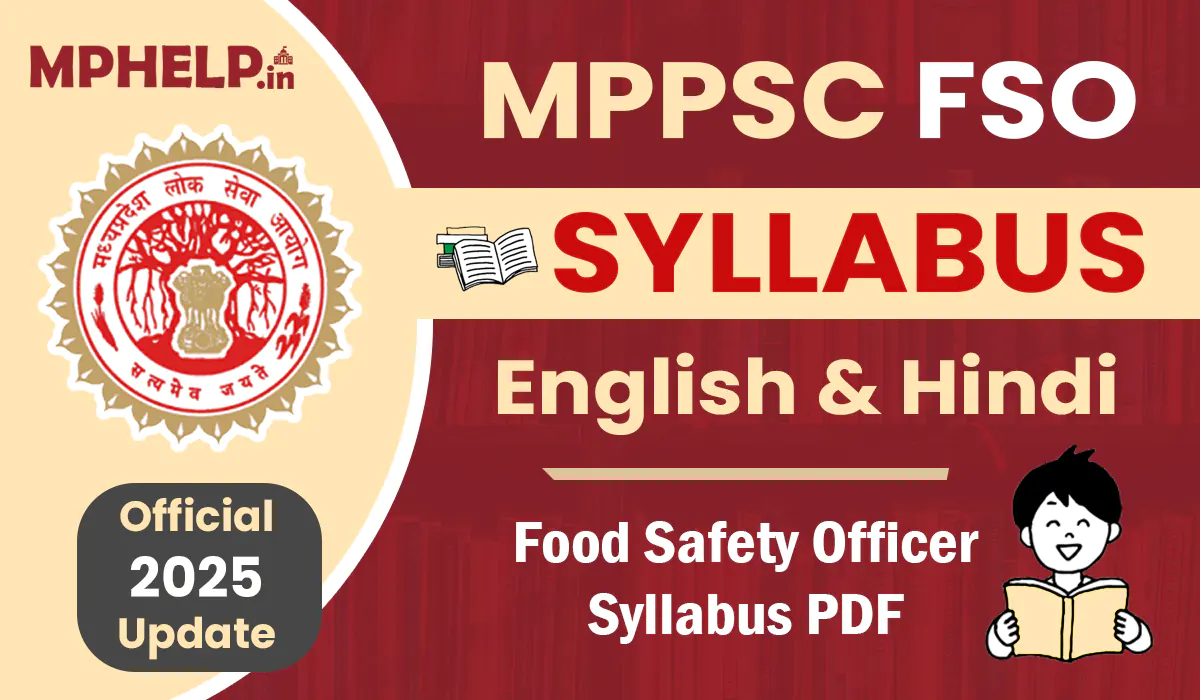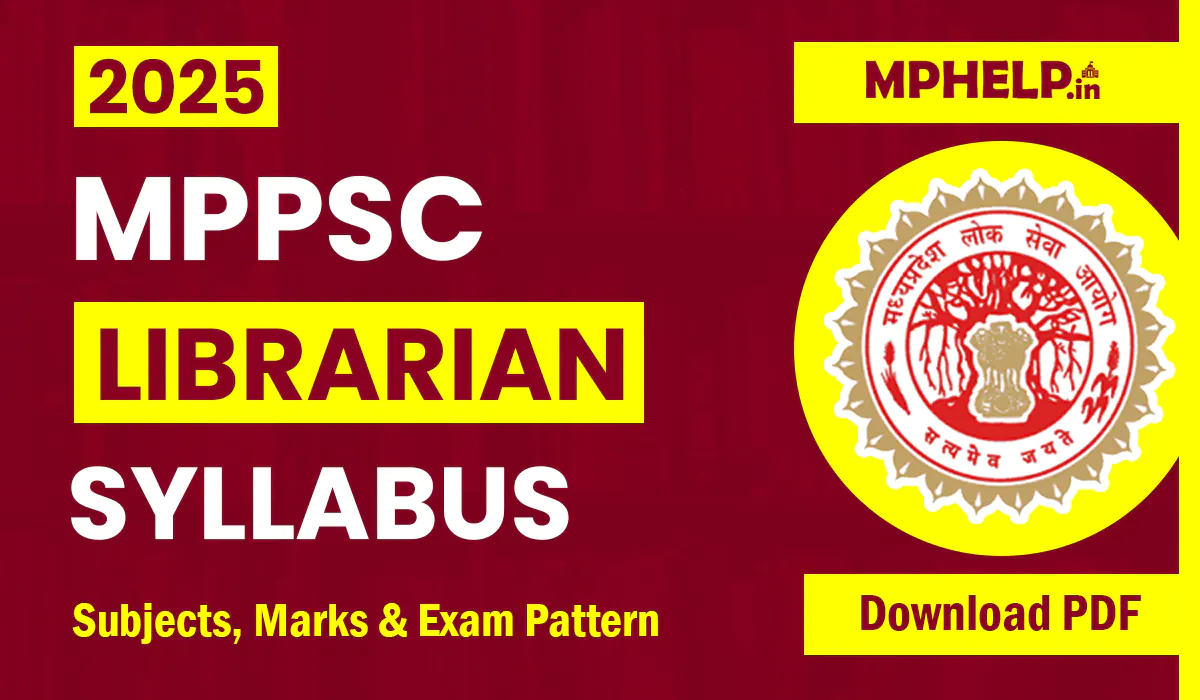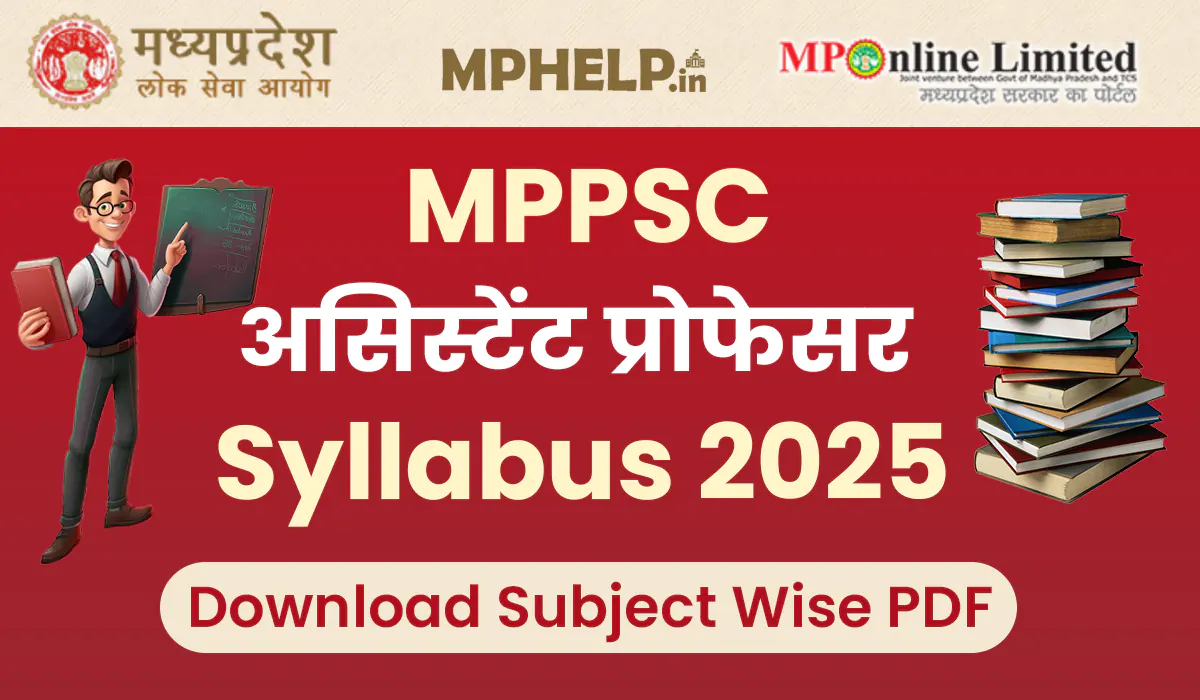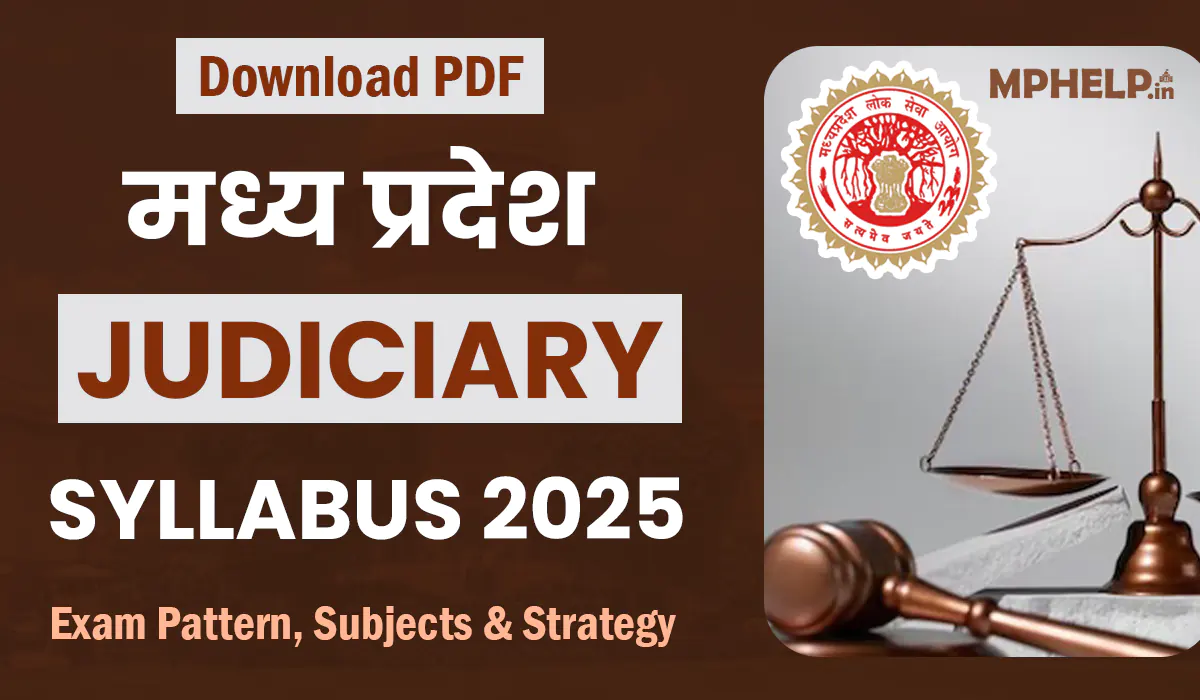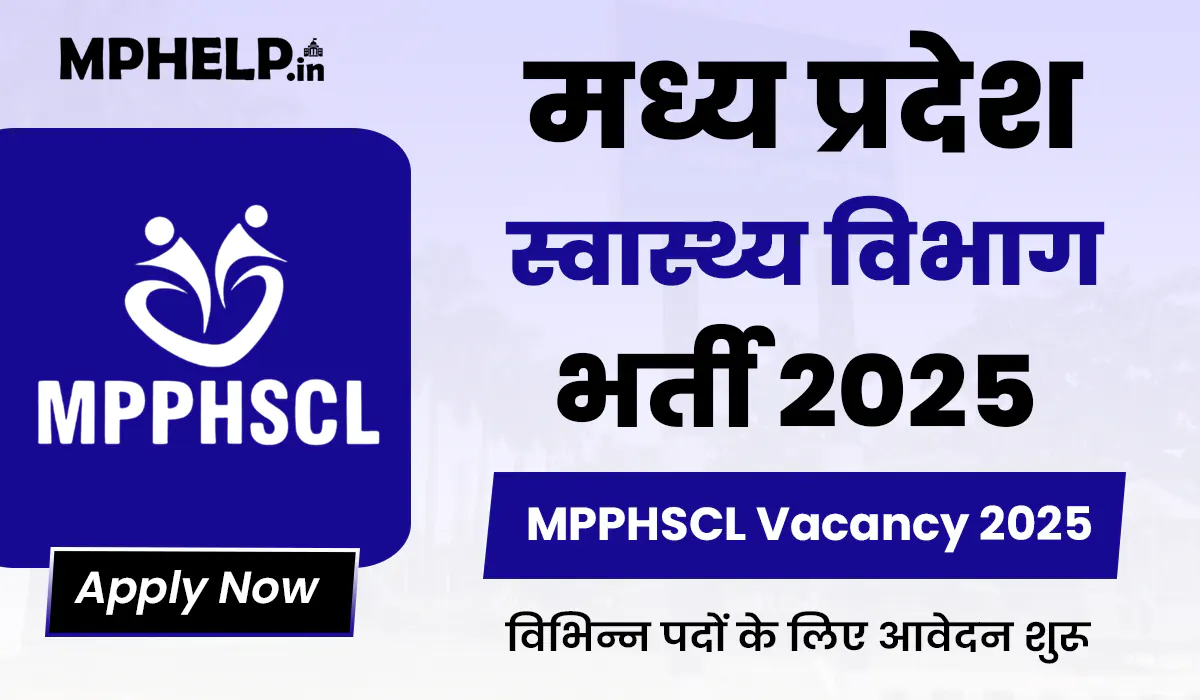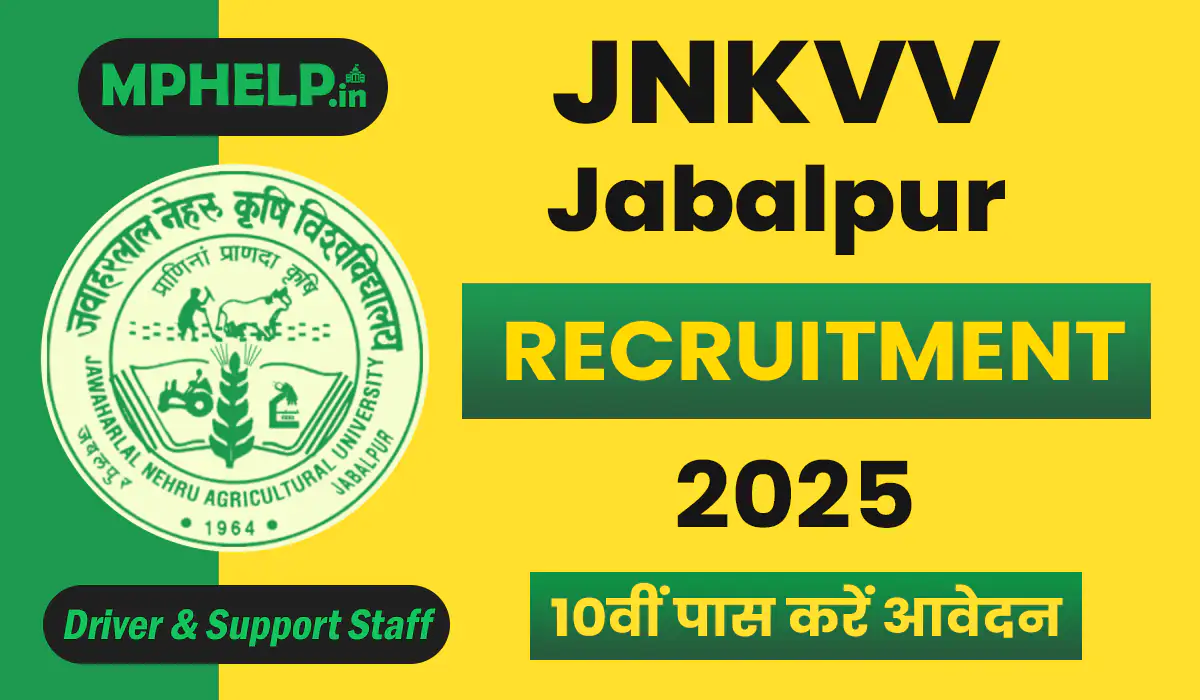MPPSC State Forest Service Exam Syllabus 2025 (Prelims & Mains): मध्य प्रदेश लोक सेवा आयोग (MPPSC) हर साल स्टेट फारेस्ट सर्विस परीक्षा आयोजित करता है। इसका सिलेबस और एग्ज़ाम पैटर्न आधिकारिक वेबसाइट mppsc.mp.gov.in पर जारी होता है। यह परीक्षा राज्य वन सेवा विभाग में सहायक वन संरक्षक (ACF) और फॉरेस्ट रेंजर जैसे पदों के लिए उम्मीदवारों का चयन करती है। जो उम्मीदवार परीक्षा की तैयारी कर रहे हैं उन्हें MPPSC State Forest Service Syllabus और एग्जाम पैटर्न के बारे में अच्छी तरह से पता होना चाहिए।
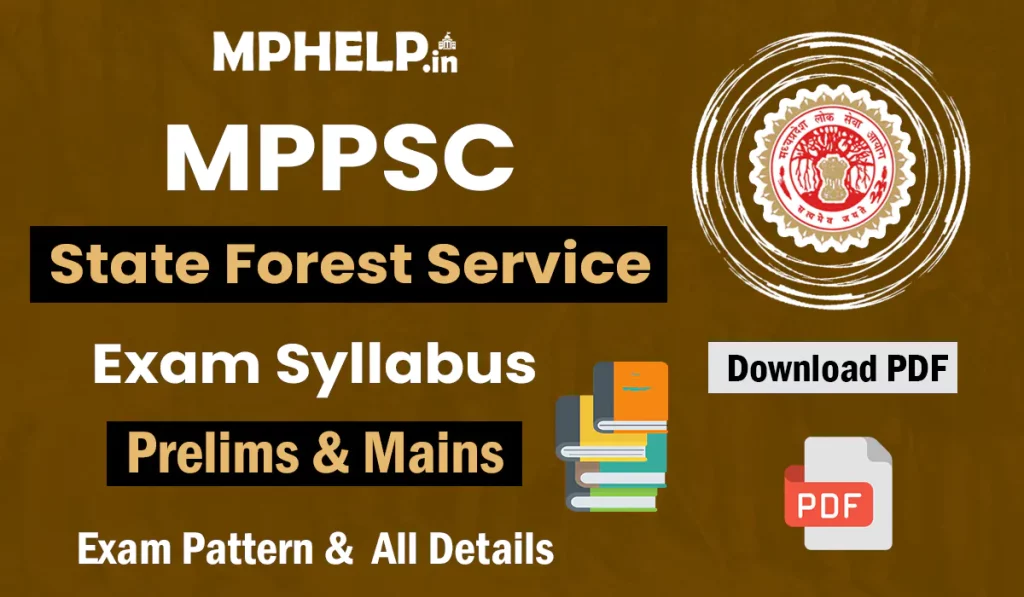
2025 के लिए अभी आधिकारिक अधिसूचना जारी नहीं हुई है, लेकिन पिछले वर्षों के सिलेबस और पैटर्न के आधार पर तैयारी शुरू करना समझदारी होगी। सिलेबस को समझना और एग्ज़ाम पैटर्न का अध्ययन करना आपकी तैयारी का पहला कदम है।
इस लेख में हम आपको सिलेबस, एग्ज़ाम पैटर्न और तैयारी के टिप्स देंगे ताकि आपकी तैयारी सही तरीके से कर पाए। एग्जाम के लेटेस्ट अपडेट्स के लिए आधिकारिक वेबसाइट चेक करते रहें।
MPPSC State Forest Service Syllabus 2025 Details
| सिलेबस का नाम | MPPSC State Forest Service Syllabus 2025 |
|---|---|
| परीक्षा आयोजित करने वाली संस्था | Madhya Pradesh Public Service Commission (MPPSC) |
| भर्ती का नाम | MP State Forest Service Recruitment 2025 |
| चयन प्रक्रिया | Prelims + Mains + Interview + Physical Test + Medical |
| कुल मार्क | Prelims: 400, Mains: 400, Interview: 50 |
| परीक्षा मोड | Prelims: Offline (OMR), Mains: Offline (OMR) |
| आधिकारिक वेबसाइट | mppsc.mp.gov.in |
MPPSC State Forest Service Exam Pattern 2025
इस परीक्षा में पांच चरण होते हैं – प्रीलिम्स, मेन्स, इंटरव्यू, फिजिकल मेजरमेंट टेस्ट और मेडिकल टेस्ट। सही रणनीति और मेहनत से आप इन चरणों को पार कर सकते हैं। सही रणनीति और मेहनत से आप इन चरणों को पार कर सकते हैं।
Prelims Exam Pattern
| पेपर | विषय | अंक | समय |
|---|---|---|---|
| Paper I | General Studies | 200 | 2 घंटे |
| Paper II | General Aptitude Test | 200 | 2 घंटे |
Mains and Interview Exam Pattern
| परीक्षा | विषय | प्रश्न | अंक | समय |
|---|---|---|---|---|
| Mains (Written) | सामान्य ज्ञान (MP, राष्ट्रीय, अंतरराष्ट्रीय) | 50 | 150 | 3 घंटे |
| वानिकी और सामान्य विज्ञान | 100 | 300 | ||
| कुल योग | 150 | 450 | 3 घंटे | |
| Interview | व्यक्तित्व परीक्षण | – | 50 | – |
| कुल अंक | – | 500 | – |
Important Points to Remember
- प्रीलिम्स (MPPSC SFS Prelims) में 2 पेपर होंगे। पेपर I और पेपर II दोनों 200 अंकों का होंगे। इसमें कोई नेगेटिव मार्किंग नहीं है।
- प्रीलिम्स और मेन्स दोनों एग्जाम OMR आधारित होगा, दोनों हिंदी और अंग्रेजी में होंगे।
- मेन्स (MPPSC SFS Mains) में एक सेशन में 3 घंटे की ओएमआर आधारित परीक्षा होगी, जिसमें MCQ होंगे।
- प्रत्येक सही उत्तर के लिए 3 अंक, गलत उत्तर के लिए 1 अंक की नेगेटिव मार्किंग होगा।
- सामान्य वर्ग के लिए प्रत्येक खंड (अ और ब) में 40% और आरक्षित वर्ग (SC/ST/OBC/EWS/PwD) के लिए 30% अंक जरूरी।
- परीक्षा के बाद प्रारंभिक उत्तर कुंजी वेबसाइट पर जारी होगी, 5 दिन में आपत्ति दर्ज करानी होगी। विशेषज्ञ समिति अंतिम लिस्ट तैयार करेगी।
- लिखित परीक्षा में अंकों के आधार पर 3 गुना अभ्यर्थियों को बुलाया जाएगा, अनुपस्थित होने पर अयोग्य माना जाएगा।
- अंतिम चयन, लिखित (450) और साक्षात्कार (50) के कुल अंकों के आधार पर होगा।
MPPSC State Forest Service Exam Syllabus 2025
SFS Prelims Syllabus
Paper I – General Studies
- General Science and Environment: Environmental Ecology, Biodiversity, Climate Change, everyday science.
- Current Events of National & International Importance: Significant events at national and global levels.
- History of India and Independent India: Social, economic, political aspects, Indian National Movement.
- Geography of India: Physical, social, economic geography, agriculture, natural resources, demography, census.
- General Geographical Awareness of World: Basic world geography.
- Indian Polity and Economy: Political system, Constitution, Panchayati Raj, sustainable development, elections, industries, trade.
- Sports: Major games, tournaments, awards, sports institutions (MP, India, Asia, World).
- Geography, History, and Culture of MP: Mountains, rivers, climate, flora-fauna, dynasties, tribal arts, historical figures.
- Polity and Economy of MP: Political system, elections, Panchayati Raj, industries, demography.
- Information and Communication Technology: Websites, email, video conferencing, cybercrime basics.
- Scheduled Caste & Scheduled Tribe: Prevention of Atrocities Act 1989, Protection of Civil Rights Act 1955, Human Rights Act 1993.
Paper II – General Aptitude Test
- Comprehension
- Interpersonal Skills including Communication Skills
- Logical Reasoning and Analytical Ability
- Decision Making and Problem Solving
- General Mental Ability
- Basic Numeracy (Class X level): Numbers, relations, order of magnitude.
- Data Interpretation (Class X level): Charts, graphs, tables, data sufficiency.
- Hindi Language Comprehension Skill (Class X level)
SFS Mains Syllabus
Section A – General Knowledge of Madhya Pradesh, National and International Level
- History, Culture, and Literature of M.P.
- Important Historical events and Major dynasties of M.P.
- Contribution of Madhya Pradesh in the Independence movements.
- Art, Architecture, and culture of M.P.
- Main Tribes and Dialects of M.P.
- Main festivals, folk music, and folk art of M.P.
- Important literary figures of M.P. and their literature.
- Main Tourist places of M.P.
- Important personalities of M.P.
- Geography of Madhya Pradesh
- Forest, Mountain, and Rivers of M.P.
- Climate of M.P.
- Natural and mineral resources of M.P.
- Energy Resources: Conventional and Non-conventional.
- Main irrigation and Power projects of M.P.
- Politics and Economy of M.P.
- Political system of M.P. (Governor, Cabinet, Legislative Assembly).
- Panchayati Raj in M.P.
- Social system of M.P.
- Demography and census of M.P.
- Economic development of M.P.
- Main industries of M.P.
- Agriculture and Agri-based industries in M.P.
- Current Events of International, National, and M.P.
- Important Contemporaneous events.
- Famous sports competitions; awards and sports institutions of the State and country.
- Welfare schemes of M.P. state.
- Famous personalities and Places.
- Information and Communication Technology
- Electronics, computers, information, and communication technology.
- Robotics, artificial intelligence, and cyber security.
- E-Governance.
- Internet and Social networking sites.
- E-Commerce.
Section B – Forestry and General Science
Unit-I: Forest and Forestry
- Definitions, terminology, history, and background of forest, objective of forestry, role of forest (productive, protective, and ameliorative), forest cover of India and M.P., influence of forest on environment, forest types of India and M.P., reasons for declining forest, classification of forest, Trees Outside Forest (TOF), state-wise forest distribution and growing stock, silvics and silviculture, forest regeneration, some commercially important trees (botanical name and family) examples: teak, shisham, sal, babul, harra, bahera, amla, tendu, palash, arjun, khair, mahua.
Unit-II: Forest Utilization
- Definitions, terminology, wood product, wood seasoning, wood preservation, plywood, particle-wood, pulp and paper, saw milling, logging, forest measurements (tree height, volume, biomass), non-wood forest products: fibres, flosses, grasses, tannin, gums, dye, resin, oleoresin, essential oils, tree-borne oil seeds, medicinal plants.
Unit-III: Forest Policy and Legislation
- Definitions, terminology, National Forest Policies (1894, 1952, 1988), Forest Law, Indian Forest Act (1927, 2002, 2006), comparison of forest Policies, Wild Life Protection Act (1972) and its amendments, Forest Conservation Act (1980) and amendments, Environment Protection Act 1986, Biodiversity Act 2002, Forest Right Act 2006 for tribals, Indian Forest Act 2019 (Amendment), Bamboo freed from forest produce, joint forest management, social forestry, agroforestry, farm forestry, Agroforestry Policy 2014, M.P. Lokvaniki Act, 2001.
Unit-IV: Forest Protection
- Definitions, terminology, Classification of injurious agencies – man, animals, insects, plants, environmental factors, forest fires and control measures, grazing and grazing management, afforestation, soil conservation, watershed management, Global warming, role of forest in climate mitigation, carbon pool, role of forest in soil and water conservation, National parks, Census, ecosystem services, forest management, reserve forest, Biosphere reserves.
Unit-V: Tribes of Madhya Pradesh
- Major Tribes of M.P. and its sub-castes – Bhil, Gond, Baiga, etc.
- Special backward tribes of M.P. – Baiga, Bhariya, Sahariya.
- General introduction, regions, and their features of languages and dialects of tribes of M.P., Major institutions and museums for tribes in M.P., Festivals, Religious beliefs, Culture, and traditions of tribes of M.P., Welfare Schemes of tribes, Role of tribes in forest protection.
Unit-VI: Chemistry
- Rate of chemical reaction and chemical equilibrium – Preliminary knowledge of rate of chemical reaction. Fast and slow chemical reactions. Reversible and irreversible chemical reactions. Reversible reaction and dynamic nature of equilibrium. Acids and bases. pH scale [simple numerical questions]. Exothermic and endothermic reactions. Some important chemical compounds – properties and uses. Method of production, manufacture [water, washing soda, baking soda, bleaching powder, and plaster of Paris]. Preparation of building materials – lime, cement, glass, and steel.
- Metals – Position of metals in the periodic table and general properties. Metal, mineral ore. Difference between mineral and ore. Metallurgy – concentration, roasting, smelting, refining of ores. Metallurgy of copper and Iron, corrosion of metals. Alloys. Nonmetals – Position of nonmetals in the periodic table. Preparation properties and uses of hydrogen, oxygen, and nitrogen. Some important organic compounds – laboratory method of preparing alcohol and acetic acid, properties and uses of some general artificial polymers, polythene, polyvinyl chloride, Teflon, soap, and detergents.
Unit-VII: Physics
- Source of Energy – Conventional and new sources of Energy, source of solar energy, causes of origin of energy in the Sun, solar heating devices, solar cooker, solar cell, wind energy, biogas, fossil fuels, ideal fuel, properties of ideal fuel. Nuclear energy, nuclear Fission, Fusion, chain reaction, nuclear reactor, uses and harms of nuclear energy. General information about M.P. energy development corporation (MPUVN).
- Light – nature of light, reflection of light, laws of reflection, reflection from plane and curved surface, image formation by plane convex and concave mirror, relation between focal length and radius of curvature, determination of focal length of concave mirror by single pin method. Relation between u-v-f [numerical examples]. Refraction of light – laws of refraction, refraction by glass slab, critical angle, total internal reflection, use of total internal reflection in daily life. Lens [converging and diverging lens]. Definition focal length optical centre image formation by lens. Human eye, its defects and remedies. Comparison between photographic camera and human eye. Simple telescope and astronomical telescope – Construction, working, uses, ray diagram [no formula derivation].
- Electricity and its effects – electric intensity, potential, potential difference, electric current, Ohm’s law. Resistance specific resistance, influencing factors, combination of resistance and related numerical examples, thermal effect of current its use, calculation of power and electrical energy spent (numerical), precautions observed in electric experiments. Chemical effects of electric current. Primary and secondary cells their properties and drawback. Leclanche cell, dry cell, lead accumulator cell, construction. Magnetic effect of current – Oersted experiment, electromagnetic induction, electric motor, working principle and use of generator, general studies of alternating current and direct current, electric discharge in gases, discharge tube, cathode rays. X-rays and their properties.
- Magnetism – Magnet and its types, artificial magnet, methods of preparing magnets, molecular theory of magnetism, demagnetization, magnetic keepers, magnetic lines of force and their properties. Plotting the lines of force, Terrestrial magnetism, magnetic storm, magnetic meridian geographical meridian, relation between VHI and Ø.
Unit-VIII: Biology
- Animal nutrition – Types of nutrition. Autotrophic Nutrition, Heterotrophic Nutrition. Holozoic, Parasitic, Saprophytic, Symbiotic. Insectivorous Plants. Important terms of nutrition process. Digestion in unicellular cell animal [amoeba] and multicellular animal grasshopper. Human digestive system and digestive process. Photosynthesis, main steps of the process, light reaction and dark reaction. Factors influencing Photosynthesis. Experiments related to photosynthesis.
- Respiration – Definition, respiratory organs of animals, breathing and respiration. Types of respiration. Aerobic and anaerobic respiration, respiratory system of human being and mechanism of respiration [general information], respiratory quotient [RQ] of carbohydrate, fat, and protein.
- Transport of mineral and water in plants and animals [in context of human being]. Composition and function of blood, structure and working of heart, structure and function of blood vessels [preliminary knowledge], coagulation of blood, blood group, blood transfusion, blood bank, function of lymph system, diseases related to heart.
- Excretion – Excretion in plants and excretory product. Excretion in animal and excretory organs. Excretion system of man and excretion process [general information], artificial kidney dialysis. Osmoregulation. Diseases related to kidney.
- Control and coordination – Coordination in plants and animal Phytohormones. Nervous system of human being. Structure and function of human Brain and spinal cord, reflex action, endocrine glands hormone and their function.
- Reproduction and growth – Types of reproduction. Asexual reproduction: fission, budding, regeneration, vegetative reproduction, layering, cutting, grafting, Parthenogenesis, sexual reproduction in plants, structure of flower and reproduction process [general information], pollination, fertilization. Human reproductive system and reproduction process.
- Heredity and evolution – Heredity and variation, basis of heredity, chromosome and DNA [preliminary information], gene, sex determination, preliminary knowledge of organic evolution [Oparin’s theory only]. Principles and types of plant classifications.
Unit-IX: Environment
- Bio-diversity and its conservation – General introduction – definition. Species and genetic diversity. Bio-geographic classification of India. Importance of Bio-Diversity – Constructive and Destructive application. Importance of social, moral, and alternative vision. Global, National, and Local level Bio-diversity. India as a wide diversity nation, Hotspots of Biodiversity, threats to biodiversity, Residential damage, damage to wildlife, humans and wild animals struggle. India’s threatened (endangered) and local species, Conservation of bio-diversity. Topological and Non-topological conservation.
- Environmental pollution – Reason, effect, and conservation – Air pollution, water pollution, sea pollution, soil pollution, sound/noise pollution, thermal pollution, nuclear pollution.
- Solid waste management – Urban and Industrial solid waste management: reason, effect, and control. Human role in pollution control.
- Disaster Management – Floods, Earthquake, Cyclones, and Landslide.
- Human Population and Environment – Population growth. Variation in the population in various countries. Population explosion and Family Welfare Programme. Environment and Human health.
Unit-X: Elementary Mathematics and General Mental Ability
- Arithmetic: Average, profit and loss, simple and compound interest, Area, Time, work and Labour, Time and distance, Square Root, Percentage, Ratio and Proportion, use of log table, volumes of rectangular surface and solids.
- Algebra: Fundamental laws and first four rules – additions, Subtraction, multiplication and division, simple formula and their use, factors, H.C.F., L.C.M. by factors, fractions, simple equations, factors of easy trinomial expressions of second degree.
- Geometry: Line and angles, parallels, triangles, congruence inequalities, parallelograms, applications of parallels, bisectors, perpendiculars, etc. Construction of angles, construction of triangles, construction of quadrilaterals, theorems of areas of triangles and parallelograms, Areas of quadrilaterals, theorem of Pythagoras and its converse, reduction of quadrilaterals to an equivalent triangle, reduction of a rectilinear figure to a triangle or rectangle of equal areas, construction of a rectangle of given area and having one side of given length, miscellaneous construction, loci, Intersection of loci, exercises on loci.
- Trigonometry: Circular measure, Definitions of trigonometric ratio, simple problems on height and distance.
- General Mental Ability: Numerical ability, reasoning, coding, data analysis and interpretation, and analogy.
MPPSC SFS 2025 Syllabus (Mains) और Exam Pattern की PDF आप इस लिंक से डाउनलोड कर सकते हो। Prelims की Syllabus PDF हम बहुत जल्द अपलोड करेंगे।
Physical Test for MPPSC State Forest Service Exam 2025
लिखित परीक्षा और साक्षात्कार के बाद, उम्मीदवारों को शारीरिक परीक्षण (Physical Efficiency Test – PET) और शारीरिक मापदंड (Physical Measurement Test – PMT) से गुजरना होगा। यह चरण सहायक वन संरक्षक (ACF) और फॉरेस्ट रेंजर जैसे पदों के लिए शारीरिक फिटनेस सुनिश्चित करता है। नीचे दी गई तालिका में पुरुष और महिला उम्मीदवारों के लिए न्यूनतम शारीरिक मापदंड और पैदल परीक्षा के डिटेल्स दिए गए हैं।
Physical Standards and Tests
| Details | Male | Female |
|---|---|---|
| ऊंचाई (UR, OBC, SC) | 163 cm | 150 cm |
| ऊंचाई (ST) | 152 cm | 145 cm |
| छाती (Chest – Unexpanded) | 79 cm | 74 cm |
| छाती (Chest – Expanded) | 84 cm (5 cm expansion) | 79 cm (5 cm expansion) |
| Walking Test | 25 km in 4 hrs | ACF: 14 km in 4 hrs FR & PM: 16 km in 4 hrs |
Preparation Strategy & Tips for MPPSC State Forest Service Exam 2025
MPPSC स्टेट फारेस्ट सर्विस 2025 की तैयारी के लिए सही रणनीति जरूरी है।
- प्रीलिम्स में प्रश्न सॉल्व करने की गति को बढ़ाना है
- 200 अंकों के 2 पेपर 4 घंटे में हल करने हैं। GK को जल्दी खत्म करना है, एप्टीट्यूड पर ज्यादा समय देना है।
- Tip: रोजाना 50 प्रश्नों का अभ्यास करना है, पिछले पेपर्स देखो।
- मेन्स में सिलेबस को समझें और प्राथमिकता दें
- खंड ‘अ’ (50 प्रश्न, 150 अंक): मध्य प्रदेश GK पर ज्यादा ध्यान दें, क्योंकि यह स्कोरिंग के लिए आसान रहेगा।
- खंड ‘ब’ (100 प्रश्न, 300 अंक): वानिकी और सामान्य विज्ञान में गहराई से तैयारी करें, क्योंकि यह ज्यादा वेटेज रखता है।
- दोनों खंडों में 40% (सामान्य) या 30% (आरक्षित) न्यूनतम अंक जरूरी हैं, इसलिए संतुलन बनाना पड़ेगा।
- MCQ अभ्यास पर जोर देना है
- रोज 100-150 MCQ हल करें, खासकर पिछले MPPSC पेपर और वन-संबंधित परीक्षाओं (जैसे ICFRE) से।
- नेगेटिव मार्किंग से बचने के लिए सटीकता बढ़ाना है, अनुमान कम करें, केवल पक्के जवाब देना जरूरी।
- टाइमर सेट कर 3 घंटे में 150 प्रश्न हल करने की प्रैक्टिस करें।
- मध्य प्रदेश GK को मजबूत करें
- इतिहास, भूगोल, जनजातियाँ, और योजनाओं पर नोट्स बनाएँ। ‘मध्य प्रदेश एक परिचय’ जैसी किताबें पढ़ें।
- करेंट अफेयर्स के लिए मासिक मैगजीन और MP-फोकस्ड वेबसाइट्स फॉलो करें।
- वानिकी और विज्ञान में बेसिक्स क्लीयर करें
- वानिकी: ‘Indian Forestry’ (K Manikandan) और MPPSC पिछले पेपर से टॉपिक्स कवर करें।
- विज्ञान: NCERT (6वीं-10वीं) से फंडामेंटल्स मजबूत करें, खासकर बायोलॉजी और पर्यावरण।
- वन नीतियाँ और कानून (1927, 1980, 2006) रट लेने से, ये आगे जाके मदद करेगा।
- नेगेटिव मार्किंग से बचने की रणनीति
- पहले आसान प्रश्न हल करें, कठिन को छोड़ना है, हर प्रश्न में 3 अंक का मौका है, लेकिन 1 अंक गंवाना महंगा पड़ेगा।
- 70-80% सटीकता का लक्ष्य रखना है, 100-120 प्रश्न सही हों जाए तो स्कोर (300-350) लाना संभव है।
- मॉक टेस्ट और रिवीजन
- हफ्ते में 2-3 फुल-लेंथ मॉक टेस्ट देना है, स्कोर एनालिसिस भी करना है।
- कमजोर टॉपिक्स पर रोज 1 घंटा रिवीजन करें, वानिकी टर्म्स और MP फैक्ट्स को मेमोराइज़ करें।
- साक्षात्कार की तैयारी
- मेन्स के साथ-साथ व्यक्तित्व विकास शुरू करें, वन संरक्षण, पर्यावरण, और MP से जुड़े मुद्दों पर राय बनाएँ।
- मॉक इंटरव्यू करने से आत्मविश्वास बढ़ेगा।
- फिजिकल टेस्ट की तैयारी करो
- 25 किमी (पुरुष) या 14-16 किमी (महिला) चलने की प्रैक्टिस शुरू करो।
- Tip: रोज 5 किमी अभ्यास करना है।
शुरुआत में 6-8 घंटे पढ़ाई करें और आखिरी 2 महीने 10-12 घंटे तक बढ़ाना है। सटीकता और स्पीड का बैलेंस बनाकर इस MPPSC State Forest Service Exam 2025 में सफलता हासिल की जा सकती है।
